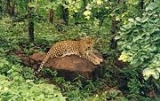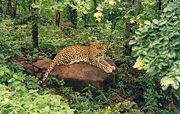
Van Vihar National Park
Encyclopedia
Van Vihar National Park is a national park
in India
located a the heart of Bhopal, the capital city of Madhya Pradesh
. Declared a national park in 1983, it covers an area of about 4.45 km². Although it has the status of a national park, Van Vihar is developed and managed as a modern zoological park, following the guidelines of the Central Zoo Authority. The animals are kept in their near natural habitat. Most of the animals are either orphaned brought from various parts of the state or those, which are exchanged from other zoos. No animal is deliberately captured from the forest. Van Vihar is unique because it allows easy access to the visitors through a road passing through the park, security of animals from poachers by building trenches and walls and providing natural habitat to the animals.
Realizing importance of both in-situ and ex-situ conservation of wild fauna, it was decided to provide this area a legal umbrella under the Wildlife (protection) Act, 1972. A committee of experts was constituted to decide the modalities for constitution of this area as a Protected Area. An area of 4.4521 km² was notified as National Park in the year 1983 as per the committee's recommendation.
Out of the 4.4521 km² of land, an area 3.8839 km² was government revenue land and rest belonged to the villagers of Prempura, Dharampuri and Amkheda. A compensation of Rs. 23.52 lakhs was paid to villagers to acquire 0.5692 km² of private holdings. After the constitution of National Park, such acquired area was enclosed in succession with stonewall and chain link fence. Efforts of protection and habitat improvement measures resulted in its enrichment in a very short period of time.
The degraded hillock of Shyamla Hill along with private village land was initiated in 1980 and finally notified as a national park in 1983. Funding from Central Zoo Authority started in 1993-94 and also granted Van Vihar as a medium sized zoo on the same year. With the dedicated efforts of the park management, this area has now been transformed into an oasis of greenery. The area today serves as the green lung for Bhopal City.
 Van Vihar categorises animals in two categories, captive and herbivores. All carnivorous animals are kept inside enclosed areas and herbivores are allowed to roam freely.
Van Vihar categorises animals in two categories, captive and herbivores. All carnivorous animals are kept inside enclosed areas and herbivores are allowed to roam freely.
, panther
, lion
, bear
, hyena
, crocodiles, alligators, python etc., are kept in captivity in a system of kraal and enclosures in lines of modern concept of zoo management as per the norms of Central Zoo Authority. All felids and hyenas are fed with buffalo meat, mutton and poultry. Bears are provided with milk, vegetables and fruits to make a balanced diet.
Van Vihar also preserves animals belonging to endangered species.
Van Vihar administration is promoting cycling in Park.
National park
A national park is a reserve of natural, semi-natural, or developed land that a sovereign state declares or owns. Although individual nations designate their own national parks differently A national park is a reserve of natural, semi-natural, or developed land that a sovereign state declares or...
in India
India
India , officially the Republic of India , is a country in South Asia. It is the seventh-largest country by geographical area, the second-most populous country with over 1.2 billion people, and the most populous democracy in the world...
located a the heart of Bhopal, the capital city of Madhya Pradesh
Madhya Pradesh
Madhya Pradesh , often called the Heart of India, is a state in central India. Its capital is Bhopal and Indore is the largest city....
. Declared a national park in 1983, it covers an area of about 4.45 km². Although it has the status of a national park, Van Vihar is developed and managed as a modern zoological park, following the guidelines of the Central Zoo Authority. The animals are kept in their near natural habitat. Most of the animals are either orphaned brought from various parts of the state or those, which are exchanged from other zoos. No animal is deliberately captured from the forest. Van Vihar is unique because it allows easy access to the visitors through a road passing through the park, security of animals from poachers by building trenches and walls and providing natural habitat to the animals.
History
About two decades back, a number of illegal stone quarries were operational in the area and being in the serene and beautiful location on the bank of big lake, many commercial organizations were trying to take hold of this valuable piece of land.Realizing importance of both in-situ and ex-situ conservation of wild fauna, it was decided to provide this area a legal umbrella under the Wildlife (protection) Act, 1972. A committee of experts was constituted to decide the modalities for constitution of this area as a Protected Area. An area of 4.4521 km² was notified as National Park in the year 1983 as per the committee's recommendation.
Out of the 4.4521 km² of land, an area 3.8839 km² was government revenue land and rest belonged to the villagers of Prempura, Dharampuri and Amkheda. A compensation of Rs. 23.52 lakhs was paid to villagers to acquire 0.5692 km² of private holdings. After the constitution of National Park, such acquired area was enclosed in succession with stonewall and chain link fence. Efforts of protection and habitat improvement measures resulted in its enrichment in a very short period of time.
The degraded hillock of Shyamla Hill along with private village land was initiated in 1980 and finally notified as a national park in 1983. Funding from Central Zoo Authority started in 1993-94 and also granted Van Vihar as a medium sized zoo on the same year. With the dedicated efforts of the park management, this area has now been transformed into an oasis of greenery. The area today serves as the green lung for Bhopal City.
Geography
The park is situated on the fringe of Upper Lake, which is a Ramsar Site and the lifeline of the capital city of Madhya Pradesh. The lake adds immense beauty to the landscape of Van Vihar. It is situated at the foot of the Shyamla Hill, which is one of the several hills constituting the geography of Bhopal.Biodiversity

Captives
The animals such as tigerTiger
The tiger is the largest cat species, reaching a total body length of up to and weighing up to . Their most recognizable feature is a pattern of dark vertical stripes on reddish-orange fur with lighter underparts...
, panther
Leopard
The leopard , Panthera pardus, is a member of the Felidae family and the smallest of the four "big cats" in the genus Panthera, the other three being the tiger, lion, and jaguar. The leopard was once distributed across eastern and southern Asia and Africa, from Siberia to South Africa, but its...
, lion
Lion
The lion is one of the four big cats in the genus Panthera, and a member of the family Felidae. With some males exceeding 250 kg in weight, it is the second-largest living cat after the tiger...
, bear
Bear
Bears are mammals of the family Ursidae. Bears are classified as caniforms, or doglike carnivorans, with the pinnipeds being their closest living relatives. Although there are only eight living species of bear, they are widespread, appearing in a wide variety of habitats throughout the Northern...
, hyena
Hyena
Hyenas or Hyaenas are the animals of the family Hyaenidae of suborder feliforms of the Carnivora. It is the fourth smallest biological family in the Carnivora , and one of the smallest in the mammalia...
, crocodiles, alligators, python etc., are kept in captivity in a system of kraal and enclosures in lines of modern concept of zoo management as per the norms of Central Zoo Authority. All felids and hyenas are fed with buffalo meat, mutton and poultry. Bears are provided with milk, vegetables and fruits to make a balanced diet.
Herbivores
Free ranging animals, such as cheetal, sambhar, blackbuck, blue bull etc. are unique features of Van Vihar. There are no enclosures for them except the outer boundaries of Van Vihar. Normally the grass and other plant species growing in Van Vihar are sufficient for these herbivores. However, in summer when the grass is scarce, green fodder produced in the fodder farm and wheat husk procured from the market is provided as a supplement.Van Vihar also preserves animals belonging to endangered species.
Avian Fauna
The wilderness of park offers an ideal habitat for a number of avian fauna. Till now about two hundred species of birds have been listed in different parts of Van Vihar. Large number of birds frequent this park, especially during winter the migratory waterfowl alight in great numbers in the adjoining extensive wetland of big lake. Park is also abode of variety of butterflies and insects.Administration
The park is maintained by the Forest Department of Madhya Pradesh. The park administration is headed by a director of the rank of conservator of forests and assisted by one assistant director, 5 range officers, 3 deputy-rangers, 4 foresters and 24 game guards. In addition to these, persons are engaged on daily wage basis, to meet the day-to-day requirement of the animal care and management.Van Vihar administration is promoting cycling in Park.

